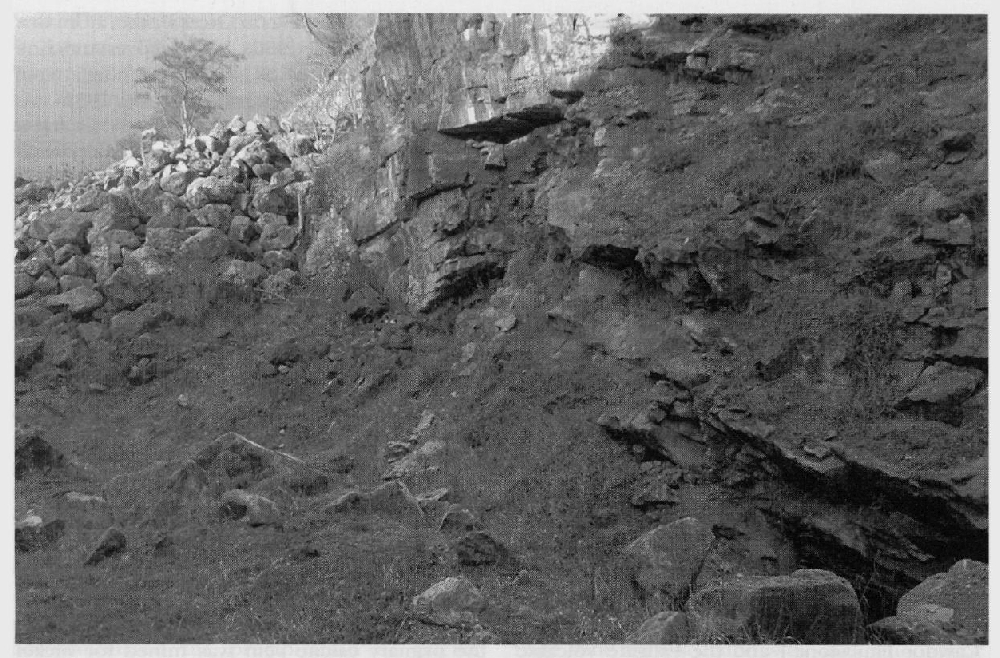Fall Hill Quarry, Derbyshire
Introduction
Fall Hill is situated on the crest of a small Visean inlier within the Namurian
Description
The Ashover Old Vein is a mineralized reverse fault, downthrown and dipping at 80° to the north-east. Smith (1982) described the geology of Fall Hill Quarry. The mineralized fault trends north-west–south-east along the crest of the Ashover Anticline. This fault has been worked at Fall Hill Quarry where the footwall is in basaltic pyroclastics (toadstone) and the hangingwall in limestone. The vein is mineralized with fluorite, galena and sphalerite. Calcite veinlets running into the pyroclastics also contain pyrite (FeS2), millerite (NiS) and chalcopyrite (CuFeS2). The vein runs the length of the anticline from Butts in the north-west to Fall Hill in the south-east. Fluorite cubes, from vugs in the vein, attain dimensions of up to 75 mm. These were coated with the iron oxyhydroxides limonite and goethite in the upper levels and carry inclusions of zoned marcasite near the quarry bottom (Smith, 1982).
Smithsonite (ZnCO3) encrusts fluorite, while galena from higher parts of the quarry is encrusted with cerussite (PbCO3) and pyromorphite (Pb5(PO4)3Cl). Barite (BaSO4) occurs as cockscomb rosettes associated with fluorite, and at times encloses small pyrite crystals. Most of the pyrite present is associated with toadstone, through which it is disseminated, particularly near calcite veining. This calcite encloses bright brassy metallic filaments of millerite, associated with small granules of chalcopyrite. A green staining of these minerals may represent both nickel and copper secondary minerals, although specific mineral species have not been identified. These nickel and copper minerals are not seen in the main vein. Quartz occurs as euhedral crystals in vugs in the limestones and in the central part of the main vein, where pyrite is also present. Hydrocarbons are usually associated with fluorite (Ewbank et al., 1993, 1995) and in one instance were enclosed by marcasite (Smith, 1982).
In the southern section of the inlier lies the E–W-trending Gregory Rake. This is a major rake vein up to 6.5 m wide, relatively high in fluorite but worked only for galena underground, which splits up into a number of 'scrins' in the southwest. In contrast to the main Ashover Old Vein there is an elevated concentration of nickel in this vein, chiefly associated with marcasite (Ixer and Townley, 1979).
Interpretation
Fall Hill Quarry demonstrates the control of lithology on mineral chemistry in the South Pennine Orefield. The
Smith (1982) described the ore mineral assemblage, but no detailed paragenesis has been determined. A sequence across the Ashover Old Vein from both walls to the centre, of calcite-sphalerite-smithsonite-calcite-galena-quartz, was established by Smith (1982). The Ni content of the marcasite has not been determined, although this mineral from the Gregory Rake was nickeliferous (Ixer and Townley, 1979). The formation of greenockite and hawleyite is likely to be a result of the alteration of cadmium-rich sphalerite to smithsonite. Sphalerite in the adjacent Milltown Quarry
The nickel-copper mineralization in the toadstones is distinct from the fluorite-barite-sphalerite-galena mineralization in the main vein. It reflects remobilization of nickel and copper as a consequence of hydrothermal alteration (which may or may not be associated with the South Pennine Orefield mineralization activity) of the volcanic rocks.
Thick shales overlie the limestones, while a thick volcanic pile underlies it. Both would have represented effective barriers to ore-fluid vertical migration. If the major Ashover–Crich fold is pre-Zechstein in age, it would have formed a physical barrier to the westward progress up-dip of laterally migrating mineralizing solutions. As a result, a local concentration of mineralization in the crest of the anticline beneath the shales might have occurred. In such circumstances, hydrocarbon accumulations would also have been likely to occur. Dolomitization is absent at Fall Hill, suggesting that the shale cover was intact during mineralization. The presence of a central quartz area in the vein is unusual and may be the result of silica transport from the underlying volcanic rocks. As at the Odin Mine and the Windy Knoll GCR site, both near Castleton (Derbyshire), hydrocarbons are evident just below the
The main concentration of mineralization at Ashover occurs in the south-western section of the Carboniferous limestones, where the large east–west Gregory Rake splits up into a number of scrins. This is where mineralization would be expected if solutions had broken through the volcanic rocks below, along a deep major structure. The Gregory Rake in this area does contain nickeliferous marcasite. If Gregory Rake continues across the crest of the Ashover Anticline to the east, it can be suggested that mineralization has migrated laterally up-dip into this area from an easterly direction. Alternatively, it would have had to break through volcanic rocks below the Gregory Rake before moving laterally through the limestone in the crest of the anticline.
Conclusions
Mineralization at Fall Hill Quarry consists of a limestone-hosted assemblage and a toadstone (basaltic lavas and pyroclastic rocks)-hosted assemblage. The limestone assemblage is free of nickel minerals which are present in the toadstone, absent of accompanying dolomitization and carries hydrocarbons. This strongly suggests that the mineralization of the limestones is largely a result of regional mineralization processes, and that a cover of the


